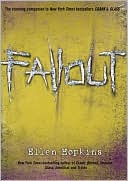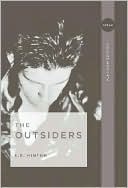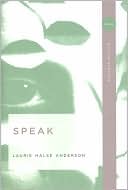The Decoding of Lana Morris
Sixteen-year-old Lana Morris wishes her life were different, that she were somewhere else, someone else. Her foster mother wants her gone, she's stuck taking care of the other kids in the house, she longs to become closer to her foster father, and the only cool people around refuse to acknowledge her. Then Lana stumbles into Miss Hekkity's mysterious shop, and she begins to realize that she might actually have the power to change things—to make some of her wishes come true. But wishing isn't...
Search in google:
Sixteen-year-old Lana Morris wishes her life were different, that she were somewhere else, someone else. Her foster mother wants her gone, she's stuck taking care of the other kids in the house, she longs to become closer to her foster father, and the only cool people around refuse to acknowledge her. Then Lana stumbles into Miss Hekkity's mysterious shop, and she begins to realize that she might actually have the power to change things—to make some of her wishes come true. But wishing isn't always as harmless as it seems. . . .Award-winning authors Laura and Tom McNeal weave a warmhearted and suspenseful story about the power—and danger—of a wish.Publishers WeeklyThis latest offering from the husband-and-wife team (Zipped) brims with affecting characters and an eerie plotline, colored by elements of the supernatural. Sixteen years old, headstrong and without parents, Lana Morris finds herself in a foster home full of "Snicks" (special needs kids) who are tenderly portrayed with a multitude of quirks. Their foster mother, Veronica, is hostile toward Lana, however, because Lana has a crush on Veronica's compassionate husband, Whit. In several disconcertingly romantic scenes, Whit takes advantage of Lana's misplaced affections in the interest of, in his words, "decoding" her. One of Lana's few lifelines to the outside world is Chet, her sympathetic neighbor. Lana hopes to break into his social circle of outcasts, riding in the trunk of their car to escape her routine. During one outing, Lana buys a box of paper that she comes to believe is the canvas on which she can redraw her life-a liberating idea. When Lana sketches a portrait of Veronica, her foster mother demands she erase it. Lana only gets as far as erasing one of Veronica's arms-the very arm Veronica loses soon after in a traffic accident. The sense of power Lana experiences through her sketches escalates-as do the results, which quickly spin out of control. Lana emerges as a fullyformed heroine; while some of the choices she makes may frustrate readers, her generosity and compassion for the "Snicks" should win her many fans. Ages 12-up. (May)Copyright 2007 Reed Business Information
CHAPTER ONE\ Nebraska, June, the sky white with heat.\ The dust devil begins with a pocket of unstable air where a farmer’s field of irrigated beans meets the heated asphalt of Highway 20, sending up a sudden rush of warm air that swirls and stretches higher, increasing speed. The twisting funnel of dirt and debris moves east through fields of alfalfa and wheat and corn toward the town of Two Rivers, where, in a two-storied foster home, a girl named Lana Morris lives.\ Lana is sixteen and slim, with watchful dark eyes, brown hair that falls in straight lines down her long back, and a slot between her two front teeth that was once called her most charming feature by one of the least reliable in her mother’s long line of unreliable boyfriends. He said she was pretty, too, but the truth is Lana doesn’t think anything about herself is charming or pretty, only that the slot between her front teeth is the exact thickness of a dime, something she learned by trial and error.\ Slipped into the crease behind Lana’s left ear, where some people might store a pencil or even a cigarette, you will normally find a tightly rolled two-dollar bill. With use and with time, this bill has been worn soft as cloth. Lana believes the bill was left to her by her father, believes that by unrolling it and holding it flat in her hand, she can sometimes feel the presence of the person he must have been. Lana has always believed in things. Fortune cookies. Horoscopes. That one of these days her mother (whereabouts unknown) would stop drinking, get a steady job, and buy them a little house somewhere. That her father, before he died, was nicer and less foolish than people said he was.\ Lana stares down at her open hand with mild surprise. A minute before, she’d been drawing on a yellow legal pad, and now, without remembering doing it, she’s smoothing the two-dollar bill across the flat of her palm.\ Lana rolls and fastens the bill, then tucks it behind her ear. Today will be okay, she thinks, if I can just get out of the house.\ Always a big if.\ It’s Saturday morning, for one thing. School is out for the summer. Whit Winters, her foster father, is upstairs asleep. His wife, Veronica, is in the backyard hanging sheets. Lana makes a point of being where Veronica isn’t, so she’s sneaked out to the front porch and sits sketching on a yellow legal tablet and eating Froot Loops from a box with a foster girl named Tilly, who is also sixteen. With her curly brown hair, green eyes, and round body, Tilly looks almost normal, but she isn’t.\ “Look, Lana!” Tilly says, and Lana looks. Tilly holds open her pudgy hand to display a dozen or so Froot Loops, all pink. “Look! Look!”\ “Pink is definitely your favorite,” Lana says.\ Tilly says seriously, “Pinkies are better than yellows, Lana. You bet.”\ They both fall quiet in the thick heat. Lana goes back to sketching Whit Winters’s face from memory. She can do his wavy hair, and she’s never had trouble with his eyes, but there’s something wrong with the chin, and if the chin’s wrong, everything’s wrong. He looks sharp and bony instead of smooth and boyish. She erases quickly, whisks the pink rubbery dust away with the side of her hand, and starts again.\ Cicadas are whirring in the cottonwood, and a crow descends on the front lawn. Lana, lost again in her drawing, presumes this is a Saturday morning like any other Saturday morning, but in this she is wrong.\ From the Hardcover edition.
\ Publishers WeeklyThis latest offering from the husband-and-wife team (Zipped) brims with affecting characters and an eerie plotline, colored by elements of the supernatural. Sixteen years old, headstrong and without parents, Lana Morris finds herself in a foster home full of "Snicks" (special needs kids) who are tenderly portrayed with a multitude of quirks. Their foster mother, Veronica, is hostile toward Lana, however, because Lana has a crush on Veronica's compassionate husband, Whit. In several disconcertingly romantic scenes, Whit takes advantage of Lana's misplaced affections in the interest of, in his words, "decoding" her. One of Lana's few lifelines to the outside world is Chet, her sympathetic neighbor. Lana hopes to break into his social circle of outcasts, riding in the trunk of their car to escape her routine. During one outing, Lana buys a box of paper that she comes to believe is the canvas on which she can redraw her life-a liberating idea. When Lana sketches a portrait of Veronica, her foster mother demands she erase it. Lana only gets as far as erasing one of Veronica's arms-the very arm Veronica loses soon after in a traffic accident. The sense of power Lana experiences through her sketches escalates-as do the results, which quickly spin out of control. Lana emerges as a fullyformed heroine; while some of the choices she makes may frustrate readers, her generosity and compassion for the "Snicks" should win her many fans. Ages 12-up. (May)\ Copyright 2007 Reed Business Information\ \ \ \ \ VOYA\ - Marla K. Unruh\ Sixteen-year-old Lana finds herself in yet another foster home, this time with four special-needs youth, a foster father who flirts with her, and a foster mother who is as cold as ice. On a chance visit to an antique shop, Lana buys a Ladies Drawing Kit. Slowly she realizes that the scenes she draws on this remarkable paper come true. When Veronica, the foster mother, insists that Lana erase the drawing in which Veronica is depicted as the Ice Queen, Lana only gets one arm erased. Shortly afterwards, Veronica is in a car accident and loses an arm. Not wanting to accidentally hurt anyone else, Lana tries to help Chet, the boy next door who has showed her kindness, and Garth, a foster brother, with mixed results. When it becomes clear that the state will close the foster home, forcing Lana and her foster brothers and sister to be separated, Lana asks Chet to drive them all back to the antique shop, where she hopes to find another drawing kit with special powers. Fully realized characters, both teen and adult, make this book a captivating read. In distinct and thoughtfully crafted voices, characters reveal zany teen humor, adolescent longings, adult treachery, and youthful belief that wrongs should be righted. The touch of fantasy that drives the plot highlights a universal teen dilemma-how to use the power of personal decision. The ending seems a bit contrived, but is gratifying nonetheless and should add to this novel's wide appeal.\ \ \ KLIATT\ - Myrna Marler\ An omniscient, sly, wise voice narrates this novel, the story of Lana Morris, a foster child, age 16, daughter of a drug-addicted mother and a dead father, who finds herself, after a lot of previous Bad Experiences, in a foster home run in a Nazi-like fashion for the "specially abled." In less politically correct terms, this means mentally challenged, autistic, or Down syndrome children whose mothers have rejected them. Lana is attracted to her foster father, who is equally attracted to her, but actually, he is not around much. He is supposed to be a house painter, but strangely, never smells of paint or turpentine. Meanwhile, his wife Veronica runs the home like a prison camp. For a social life, Lana tags along with the next-door neighbor Chet and his gang of vicious lowlife friends on their housebreaking forays or their aimless cruising about their small town in summer-hot Iowa. Lana has to ride in the trunk, which in an indication of her self-esteem, she willingly does. Then Magic enters Lana's life, and the pictures she draws foretell the future, only her forecasting comes about in unexpected ways, something like the way wishes come true in the short story "The Monkey's Paw." In other words, there's a catch. If the reader can suspend disbelief, accept the magic and enjoy the oddness of the likeable cast of characters, including the neighbor boy Chet's basic good-heartedness, this is a good story about finding self and the essential sweetness of life among the dross that surrounds it.\ \ \ \ \ School Library JournalGr 8 Up\ Lana Morris, 16, is the only non-"Snick" in a Nebraska foster home. "Snicks" are her neglectful foster mother's term for special-needs kids (SNKs). Lana is enormously lonely; kids in town are downright cruel to her, her foster mother is jealous and inattentive, and her foster father is too attentive (he and Lana share an attraction and, at one point, a kiss). Her only support comes from the mildly kind boy next door. Lana is often left in charge of the other children and has to cope as best she can with rough, complicated situations. She buys a drawing kit in an antique store and finds that anything she sketches comes to be. This is powerful stuff, and Lana learns quickly that you have to be careful what you wish for. She tries to do right, and things point to a happy ending, but the road there is very twisty. The McNeals have interesting turns of phrase and their language can be very evocative, but sometimes their characters have wisdom well beyond their years. The novel has too many issues piled on top of one another-the lives of foster children, coming of age, forbidden love, magic, self-reliance, first love, trusting others. Still, the writing is lovely and the characters are real people who elicit genuine feelings from readers. Give this story to your more mature readers who want some heft to their magical realism stories.\ —Geri DiorioCopyright 2006 Reed Business Information.\ \ \ \ \ \ Kirkus ReviewsSixteen-year-old foster child Lana Morris has a lot of wishes. She wants her conniving foster mother, Veronica, to treat her like a foster daughter rather than a housemaid and a threat. She'd like to be accepted by the local teens, have friends other than her special-needs foster brothers and sister, and to figure out her relationship with her foster father. In a cluttered antique shop with an aged proprietress, Lana finds a Ladies' Drawing Kit containing 13 pink speckled sheets of paper and some charcoal pencils. When she draws, the first two sketches come true, and now all she has to decide is what to do with the remaining 11 wishes. Then she faces the threat of ejection from her foster home. Lana draws and contemplates her wishes against a background of subplots on the nature of romance, marriage and the need to belong. The small-town summer setting gives the work a feeling of a slow, almost magical unfolding of events. Each of these events is enthralling, leading to a tidy, upbeat ending. The peripheral characters are distinctive and in Veronica's case, terrifying. A subtle yet complex, slightly surreal story about the power of wishing. (Fiction. YA)\ \








